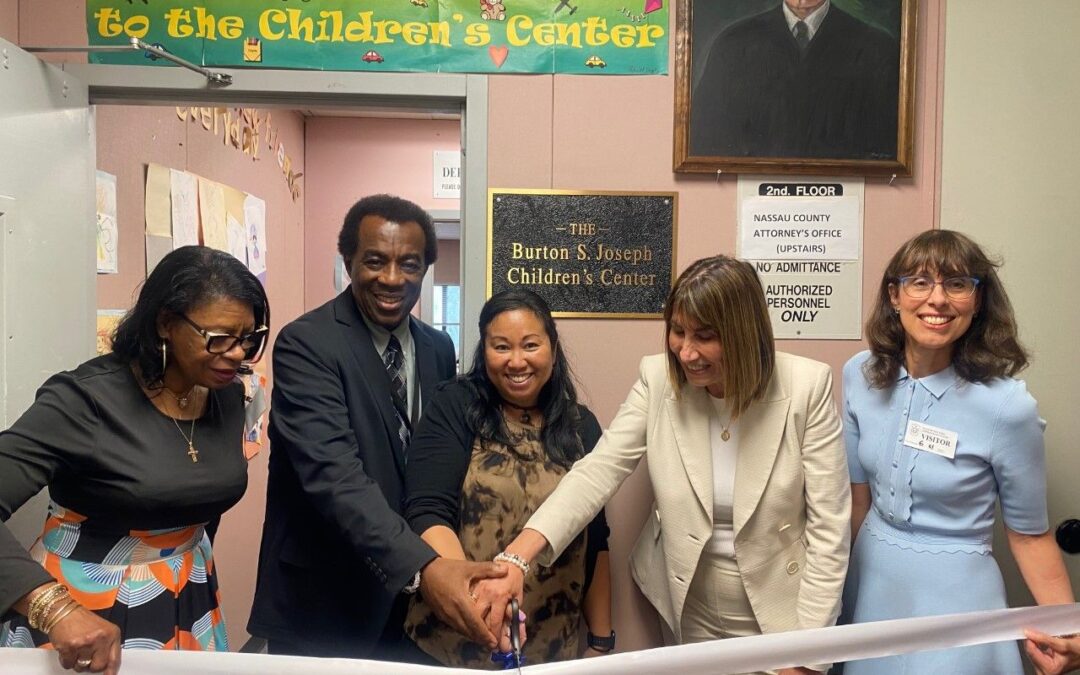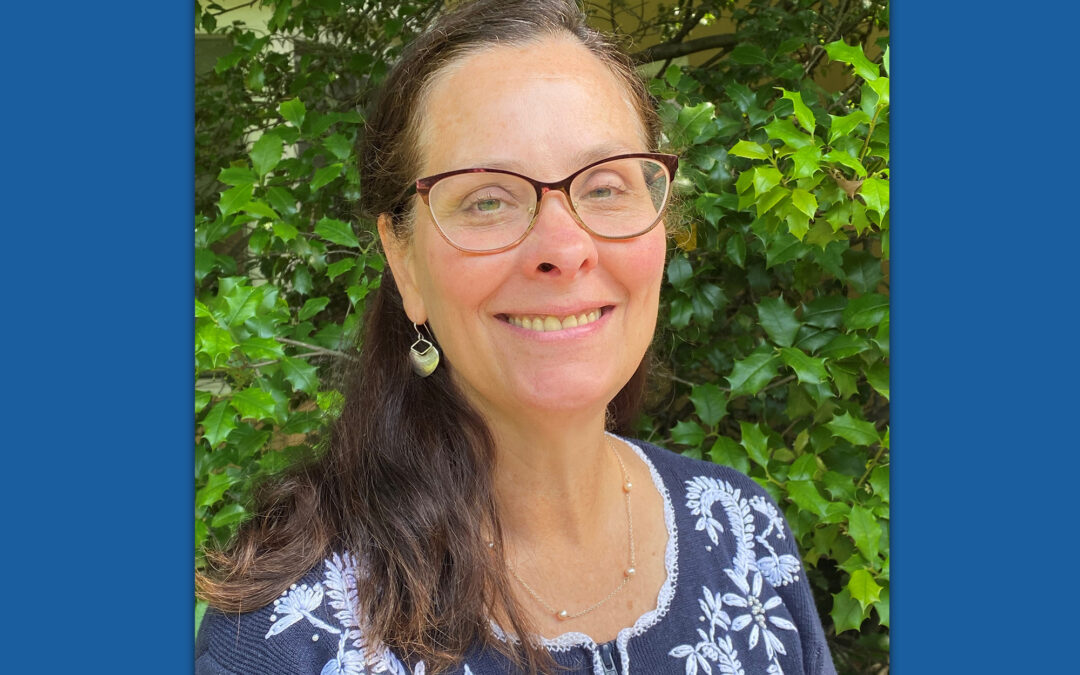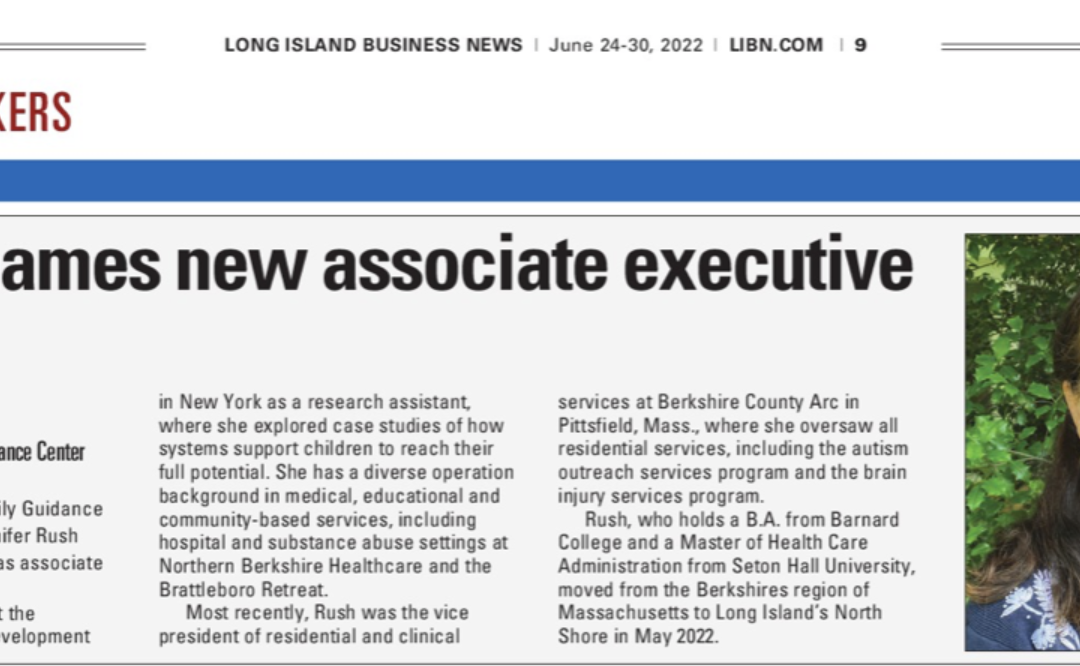
by North Shore Child & Family Guidance Center | Jul 5, 2022 | In The Media, Press Releases
North Shore Child & Family Guidance Center (the Guidance Center) is pleased to announce the reopening of the Children’s Center at Nassau County Family Court, which provides care and early learning to children while their parents or guardians are conducting court business such as divorce and custody cases. The Children’s Center had closed during the pandemic, when all Family Court activities were moved to a virtual platform.
“The Children’s Center is safe haven that allows children the opportunity to develop early learning skills through age-appropriate play and activities that are fun and exciting for toddlers and children up to age 12,” said Dr. Nellie Taylor-Walthrust, Director of the Guidance Center’s Leeds Place, under which the Children’s Center operates. “Now that the court is on a hybrid schedule with families coming back in, it’s essential that children can return to the Children’s Center so they don’t have to witness potentially contentious interactions among their family members.”
The Honorable Ellen Greenberg, Supervising Judge at Nassau County Family Court, said, “A lot of important things happen in this building, and at the Children’s Center, children will be well cared for.” While participating in the ribbon-cutting ceremony, Judge Greenberg told those gathered, “Don’t ever let anyone tell you this is just babysitting; it’s a true learning center, and families know they can leave their children here safely while they work on court matters.”
Family law attorney John M. Zenir, one of the Children’s Center’s biggest supporters, said, “The reopening is great news for the kids who come to Family Court with their parents or guardians,” said Zenir. “It means they can be safe, away from the stress and strain that’s going on between their parents. They can have a snack, read a book or play a game. In other words, just be a kid—what could be better!”
For Laurie Joseph-Yehuda, the Children’s Center is especially close to her heart, since it was founded by her father, the late Honorable Burton S. Joseph Burton. Joseph-Yehuda is a member of the Children’s Center Advisory Council, and her mother Rene painted the beautiful murals on the walls of the Children’s Center many years ago.
“The reopening of the Children’s Center is so important, because it gives children a place to come to be enriched, to learn and to be cared for,” said Joseph-Yehuda.
Another Advisory Council Member, Katherine Cho, a professor in the Criminal Justice department at Nassau Community College, brings her students to the Children’s Center. “They love to get involved with the Center,” she said. “It’s a great way for them to learn about the workings of the Family Court.”
To learn more about the Guidance Center’s Children’s Center, contact Dr. Taylor-Walthrust at 516-997-4721.
Photo: (Left to right): Dr. Nellie Taylor-Walthrust, John Aiken, Kathy Rivera, Ellen Greenberg and Rosemarie Klipper. Credit: Jenna Kern-Rugile

by North Shore Child & Family Guidance Center | Jul 5, 2022 | Blog
North Shore Child & Family Guidance Center is pleased to announce that Jennifer Rush has joined the organization as Associate Executive Director. Ms. Rush will be reporting to Executive Director/CEO Kathy Rivera.
Ms. Rush began her career at the Foundation for Childhood Development in NY as a research assistant, where she explored case studies of how systems support children to reach their full potential. She has a diverse operations background in medical, educational and community-based services, including hospital and substance abuse settings at Northern Berkshire Healthcare and the Brattleboro Retreat.
Most recently, Ms. Rush was the Vice President of Residential and Clinical Services at Berkshire County Arc in Pittsfield, Mass., where she oversaw all residential services, including the autism outreach services program and the brain injury services program. repeated “With more than 28 years of leadership experience in nonprofit, residential and health care settings, Jennifer has extensive experience working with adults, children and families in mental health and substance use,” said Kathy Rivera, Executive Director/CEO of the Guidance Center. “Her impressive level of knowledge, skill and expertise sets the stage for continued growth and expansion of the Guidance Center and will help strengthen our services across the agency.”
“I am excited to have returned to New York to work at the Guidance Center and find ways to further support the agency’s mission of bringing hope and healing to children and families,” said Ms. Rush. “I am also eager to support the Guidance Center’s incredibly dedicated employees who provide their clients g with compassionate, high-quality services that truly save lives.”
Ms. Rush, who holds a B.A. from Barnard College and a Master of Health Care Administration from Seton Hall University, moved from the Berkshires region of Massachusetts to Long Island’s North Shore in May 2022. “My two college-age children and our golden retriever are all making the transition,” she said, “and in a very short time, we are all already feeling at home.”

by North Shore Child & Family Guidance Center | Jun 27, 2022 | Blog
By guest blogger Alex Levitt, to be published in Anton Media July 1, 2022
I grew up as a sensitive kid. So much so that when my elementary school gave out superlatives to graduating 5th graders, the one I received was most self-aware. Growing up, I viewed my sensitivity as a weakness, a clear marker that separated me from my peers and gave high stakes to any social interaction I happened to find myself in. I didn’t really understand why I felt so different from other kids my age. Most seemed to wade through childhood keeping their head above water, impervious to insults and not getting bogged down in their own self-image.

Middle school is when I had my first depressive episode. It was the summer going into 8thgrade, and I got blindsided by a special brew of anxiety for the future and a persistent inner critic that wouldn’t give me any time to myself. Another wrinkle added to my situation was that my anxiety made me sick to my stomach so I could not keep down any food I ate.
This first dance in the waters of depression lasted about three weeks, which seems like the most minor of blips compared to the length of time I have been depressed since then. I have lost count of how many times depression has darkened my door. When my symptoms re-emerged, it was dispiriting because I convinced myself I was past it and would never “regress” in that way.
Yet, I don’t regret any of it. It has made me stronger, surer of myself, and—most importantly to me—compassionate about other’s hardships. Through the trial of adversity, I decided to choose growth. Not that this was easy. My biggest hurdle was bypassing my own stubbornness. I had to take my experiences and view them as a chance to better myself instead of beating myself up over my perceived “weakness.”
Mental health awareness and ending stigma is very important to me. Not just because of my own exposure, but because of the many friends and family members I have seen affected by various mental health issues. I continue to meet so many amazing and brilliant people who suffer internally because of something out of their control.

My experience and that of others made me curious about what mental health services were offered at my school, Farmingdale State College. I saw that there was one-on-one counseling on campus, but there was a lack of specialized services or peer support groups. In spring of 2021, I was part of the Student Government Association (SGA) at Farmingdale, and each semester a Senator is required to present his/her own resolution with the goal of improving services for students on campus.
I couldn’t think of a better idea than to center my resolution on expanding the mental health services on campus. There used to be more student resources for this, but the pandemic had limited those services and had yet to return in full force with options for the students. My resolution was aimed at addressing the addition of more support groups for students to discuss issues they were experiencing during the school year, and to cover a wider range of mental health concerns, such as social anxiety, depression, addiction and other mood disorders.
It got passed on the Senate floor, but it still took a while for the changes to be instituted. Luckily, a fellow Senator helped things progress further this past fall by adding his own resolution calling for more mental health services, which in effect expanded upon my resolution. This past spring, I saw flyers and even an electronic sign in front of campus advertising support groups for students, whether for anxiety, depression or other mental health issues.
There is always more to be done, but it is important that we fight to give those suffering a place where they feel they can be heard and that they are not alone.

Bio: Alex Levitt is a senior at Farmingdale State College, where he is majoring in Professional Communications. He is an intern for North Shore Child & Family Guidance Center, Long Island’s preeminent children’s mental health organization. To reach the Guidance Center, call 516-626-1971.

by North Shore Child & Family Guidance Center | Jun 23, 2022 | In The Media, Newsday
Newsday, June 20, 2022
Jennifer Rush of Huntington has been hired as associate director of the North Shore Child & Family Guidance Center in Roslyn Heights. She was vice president of residential and clinical services at Berkshire County Arc in Pittsfield, MA.







